

Boon Box
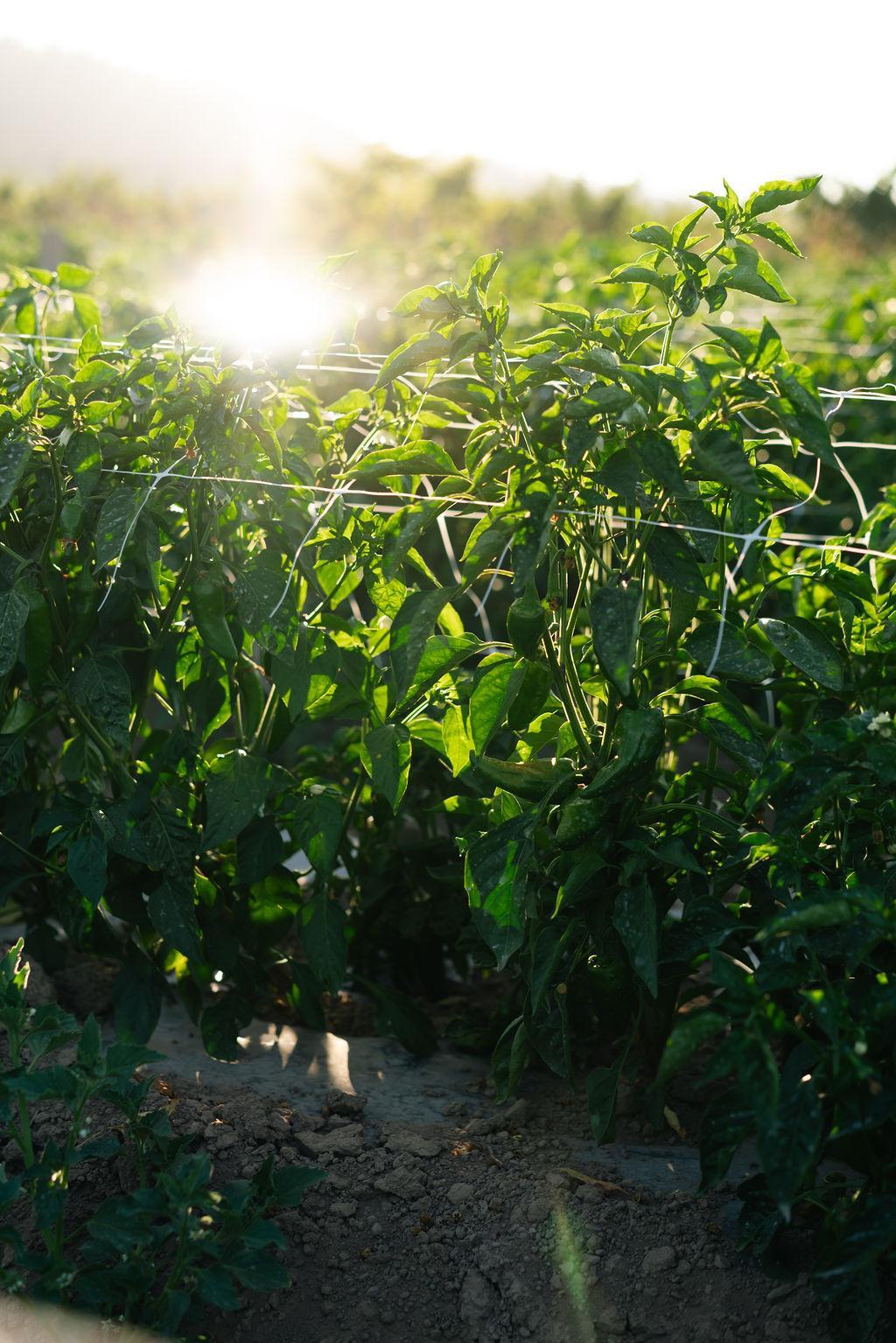

Boon Box #3
Hi again,
While this growing season is off to a fairly good start, you never really know what lies ahead. Almost one year ago, a pump critical to keeping water in our irrigation pond failed and we lost 80% of our irrigation water for the remainder of the season in 3 days. We also experienced early rains at the end of the harvest season and I made some … choices… that resulted in a loss of almost 6 tons of fresh chiles. People have asked me how the growing season is this year and I reflexively respond “it’s fine!” But the reality is that we’ve had another bummer of a year of strawberry crop, three deer spent a few nights jumping the fence into the farm enjoying a buffet of berry, strawberry and tomato plants (which live in our staff garden for our team). We had germination issues with some of our beans, and we’ve fought so many weeds that Alejandro has had to mow around the farm many more times than normal since we had such a wet winter followed by late rain in May.
But there’s also been some bright spots at the start of this growing season.
Our planting crew was incredible, as always, and was able to get all the chiles planted in 8 days. We invested in some new bean planting machines that also cut down our time to plant 4.5 acres of beans by probably close to 75% (though there is a learning curve on them and turns out you need to plant the beans closer to the drip line with these machines, something we learned while walking the fields and realizing that a lot of the beans we planted had not germinated and were just hanging out in the soil doing absolutely nothing.).
We’re also growing just under half an acre of beans at a new location this year, at a farm down the road where the owners were looking to cut down their own planted acreage and were open to renting some to us. And we’re getting ready to build a second dehydrator to be able to actually keep pace with the farm’s production capacity. These are all great things, regardless of the other regular stresses of farming that we carry.
In this box, you are getting a fan favorite chile flake, two different ways of enjoying our whole Espelette chiles, and a perfect chile for the summertime. If you have questions about what’s in your box and need help figuring out how to use the items, reach out! We’re here to help.
As a reminder, this is the 3rd and final box of your 2023-2024 Boon Box Subscription. Your subscription will NOT auto renew in the fall. We hope you’ve enjoyed everything that has come your way in the boxes.
Krissy & Gideon & Nacho & Alejandro
The Boonville Barn Team
hello@boonvillebarn.com
Follow us: @boonvillebarn
Learn more: www.boonvillebarn.com
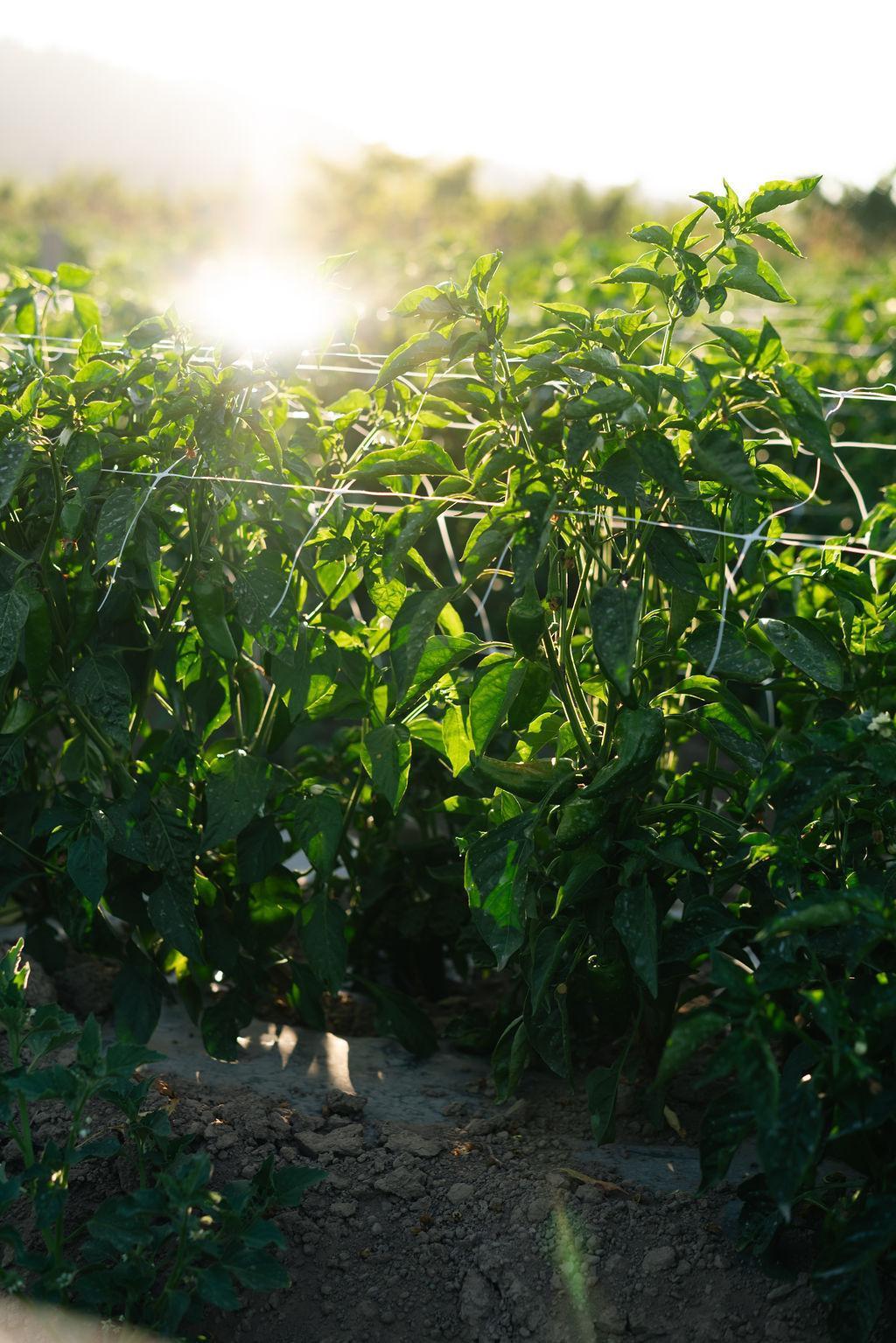
Truly the last Boon Box?
This may be the last box on so many different levels!
First, this is the last box of the 2023/2024 subscription season. If you received this as a gift, we hope you enjoyed your trip into chile pepper land. Thank you for joining us in exploring what our farm and region have to offer. For those who’ve been with us multiple years,
Second, we’re into our FINAL PALLET of the 7000 boxes that I ordered many years ago (price breaks!). Hwy 128, our narrow, twisty road to the farm, wasn’t kind to the trucking company and the pallets were in a bit of disarray when they arrived. It was … something. But I’m excited that we’ve worked through them all! And I get to this might be the
DUN dun dunnnnnn. What started as a pandemic era great idea, interest in the box has waned a bit. I think we’ve struggled a bit to keep the uniqueness of the box alive, especially as we scale up production of our crops and don’t have the most space for tiny lots of different chiles. We also recognize that it’s a LOT of chiles to get each year, especially if some are your favorites and you want to use those regularly and then are left with some
Additionally, we feel like we’ve had a hard time/failed at delivering extra value to you, our awesome subscribers. While offering discounts on items included in previous boxes was new this year (thanks for the suggestion, Heather), in the past we’d hosted little happy hours or other informal Zoom sessions as a way of chatting with
But, as we shift priorities, focus a bit on our own work life balance (fat chance as self employed farmers, but we can still try!), we’ve struggled to deliver a unique and worthwhile subscription experience. And we’ve seen that over the past few years - the sales of the Boon Box are heading down, instead of up. (Though it is important to note that about 45% of you have subscribed for more than just this year, which means it worked, kinda!)
So. We’re trying to figure out what will replace the Boon Box. I think we’re about what you think might work for us and our little farm, and what might be interesting on the receiving end. 5 year ongoing discount? More fun products made with our peppers? More pictures of Reuben? We’re open to suggestions. But right now, our current plan is to end the run of Boon Boxes here. We think this will allow folks to be able to purchase the things they really want to use instead of getting things they might not really want.
We’ve really enjoyed putting these boxes together, having a space to share more about what’s happening on the farm and what we’re growing, a space for Krissy to include her long-winded ramblings, and generally just knowing that we’ve got a dedicated group of folks here who really really like what we do. Really, thanks for being part of it.

What’s Inside Box 3


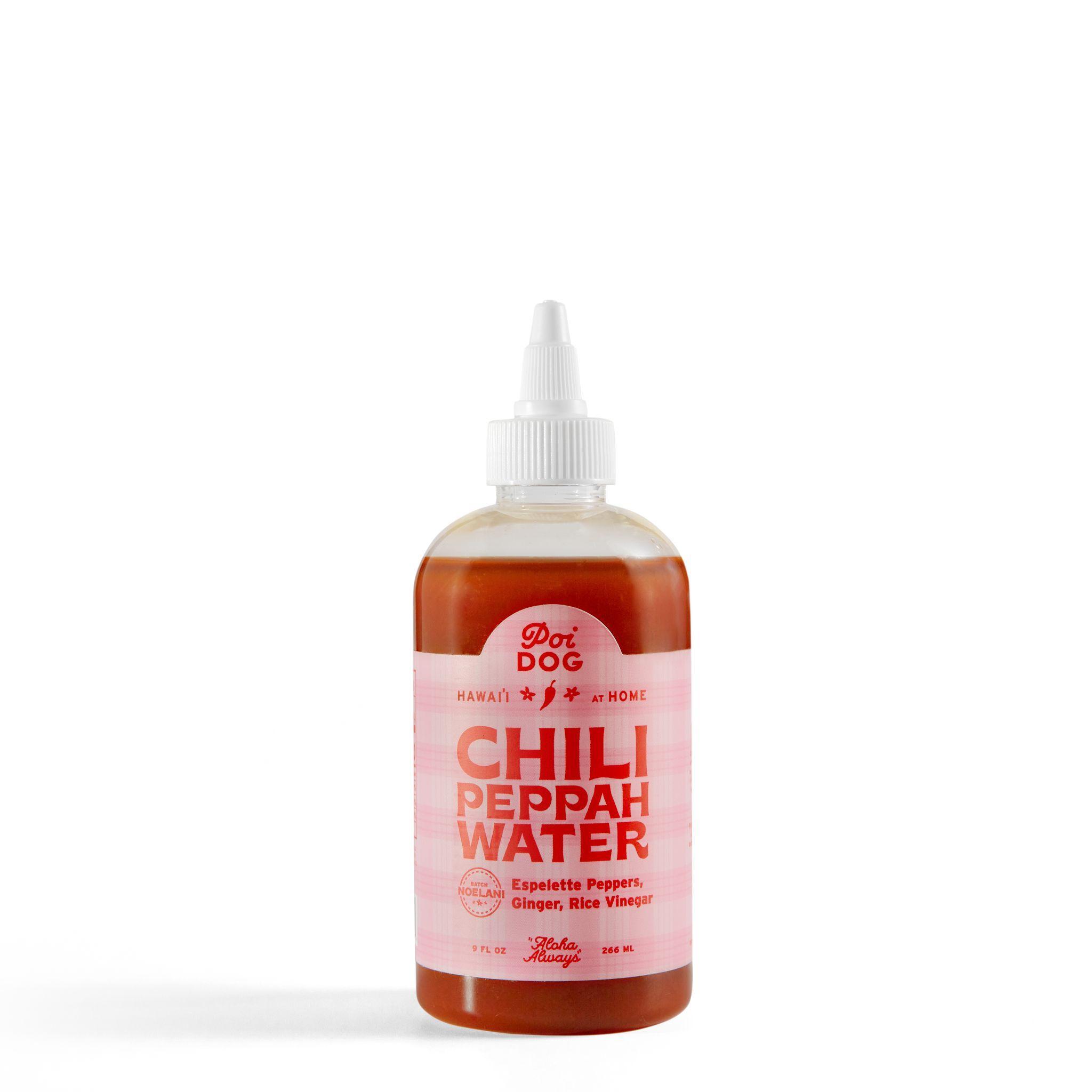

Sugar Rush Peach Chile Powder

Sugar Rush Peach chiles are a slightly confusing chile both in name and in origin. While “sugar” is in its name, there is no actual sugar added to this chile powder. All that’s in the jar is pure chile powder from these oblong peachy-yellow chile pods. These chiles are the result of an accidental hybridization of a Peruvian chile and another unknown chile in a chile breeder’s greenhouse in Wales of all places. Being one of the hottest we grow, I reach for Sugar Rush Peach with trepidation, but I’ve found the perfect way to use it in a recipe in a few pages.
2023 was our second year growing Sugar Rush Peach chiles. We originally grew these special for Curio Spice Co in Massachusetts. And if we are being honest, it has not been a chile that I regularly reach for. But I’ve been working on it! Part of this might be that my favorite way to eat the Sugar Rush chile was in an Aji Macha Crisp salsa made by Tacos Everywhere last year. Not only did they buy so many pounds of chiles from us, they made truly incredible salsa with them. It was this perfect mix of Sugar Rush and Habanero chile flakes, shallots, garlic, sesame, and oil. Ugh. It was such a dream. Much to our dismay, Tacos Everywhere closed last year and we bought up all the remaining Aji Macha Crisp for our website. It was short-lived on our website and the folks who were able to get some also became obsessed with it. I don’t know why I’m going into this love letter for this salsa that will never be again. Maybe because it really was just that good. Anyway, here are some ideas for how to use your jar of Sugar Rush Peach chile powder!
When I reached out to our recipe developer about creating a recipe using the Sugar Rush, she was frustrated that she had already developed a spicy fruit salad recipe using PdV - the SRP would be a great fit for this. The great thing about chile powders though - some are pretty interchangeable!
Our friend Sam uses Sugar Rush Peach on all fruit (shout out to sprinkling it on cantaloupe), mixes it with sugar to use on the rim of a cocktail, and uses it with lime juice instead of reaching for Tajin. I shared some of the first batch of this chile with Sam when she was in town and she said that the first way she used it was on a hot buttered biscuit. And now, she makes a spicy honey butter with it and uses it accordingly.
To make your own Spicy Honey Butter follow the linked recipe and simply use a bit of Sugar Rush Peach instead of the cinnamon and vanilla extract they call for!
I would link to a biscuit recipe, but people have strong opinions on biscuits (!) so I’ll let you find your own. If you happen to have the Six California Kitchens cookbook by Sally Schmitt, I’d recommend the cheese biscuit recipe in there (also great if you put a bit of Piment d’Ville in the batter!). I made these a few weekends ago and smothering them in Sugar Rush Peach honey butter next to a bowl of sliced peaches tossed in brown sugar. Delicious.
ANYWAY. We’re pleased to share a recipe for an old-fashioned (think Depression era!) Sugar Rush Peach Cobbler. The recipe was inspired by Curio Spice’s Josh Mamaclay telling me last year to use the Sugar Rush on roasted stone fruit a la mode. I wanted something a little more fun than an ice cream sundae. And Behold!.

Grandma Teel’s Old-Fashioned
Brown Sugar Sugar Rush Peach Peach Cobbler Recipe
Sugar rush peach chile has an immediate heat which fades quickly into a lovely tropical burn. Because it has a fruity flavor on its own, it’s a natural fit for a dessert application. For a sweet with a spicy kick, I’ve adapted my grandmother Marjorie’s easy peach cobbler recipe. She loved it because it is an easy formula where the butter melts in the preheating oven and there’s no pastry involved, just a stir-together batter. Grandma Teel likely used canned peaches, and we had success with both frozen and fresh. We poach the chile’s namesake fruit in a spiced sugar syrup and then pour the whole mixture over brown butter and brown sugar batter. They bake up together into a summery, fruit studded slump. A quarter teaspoon of chile is present but mild. A half teaspoon yields a dessert that’s both spicy and sweet, perfect with a cool shot of vanilla ice cream.Emily Teel (our recipe developer!)
½ cup (1 stick) butter
¾ cup granulated sugar
½ cup water
½ teaspoon Sugar Rush Peach Chile Powder
4 cups (1 pound) sliced frozen peaches or peeled, sliced fresh peaches
1½ cups all-purpose flour
2¼ teaspoons baking powder
¾ teaspoon salt
1 cup light brown sugar, packed
1½ cups milk
½ teaspoon vanilla extract
Vanilla ice cream or whipped cream, to serve
Place butter in a 3-quart baking dish (or a 13x9-inch pan) and place inside a cold oven. Preheat oven to 350°F.
In a large saucepan combine granulated sugar, water, sugar rush peach chile powder, and sliced peaches. Bring to a boil. Lower heat and simmer to infuse peaches with chile heat and thicken syrup slightly, about 8 to 10 minutes.
Meanwhile, combine flour, baking powder, and salt in a large bowl and whisk. Combine brown sugar, milk, and vanilla extract and whisk to dissolve sugar. Add milk mixture to flour mixture and whisk together until just combined.
When oven comes to temperature and butter is melted, pour cake mixture over the butter. Spoon peaches in over top evenly, and then pour in remaining peach syrup. Do not stir.
Bake until the center is no longer wobbly and the edges are nicely browned, 35 to 45 minutes. Cool for at least ten minutes. Serve warm with either vanilla ice cream or whipped cream.

I’m including some other ideas that Josh had last year to help you cook with the Sugar Rush.

● Josh had a similar idea to Sam as far as cocktails - you could make a seasoning with equal parts citrus zest, sugar rush, cane sugar, and flake salt to coat the rim of a mezcal cocktail.
● You could also try mixing it into a mango salsa. If you are thinking more savory;
● pair heavily spiced meat kebabs or kofte with a yogurt sauce made of greek yogurt, tahini, lime juice, salt, and the sugar rush.
● Or add it to a scallop or shrimp ceviche.
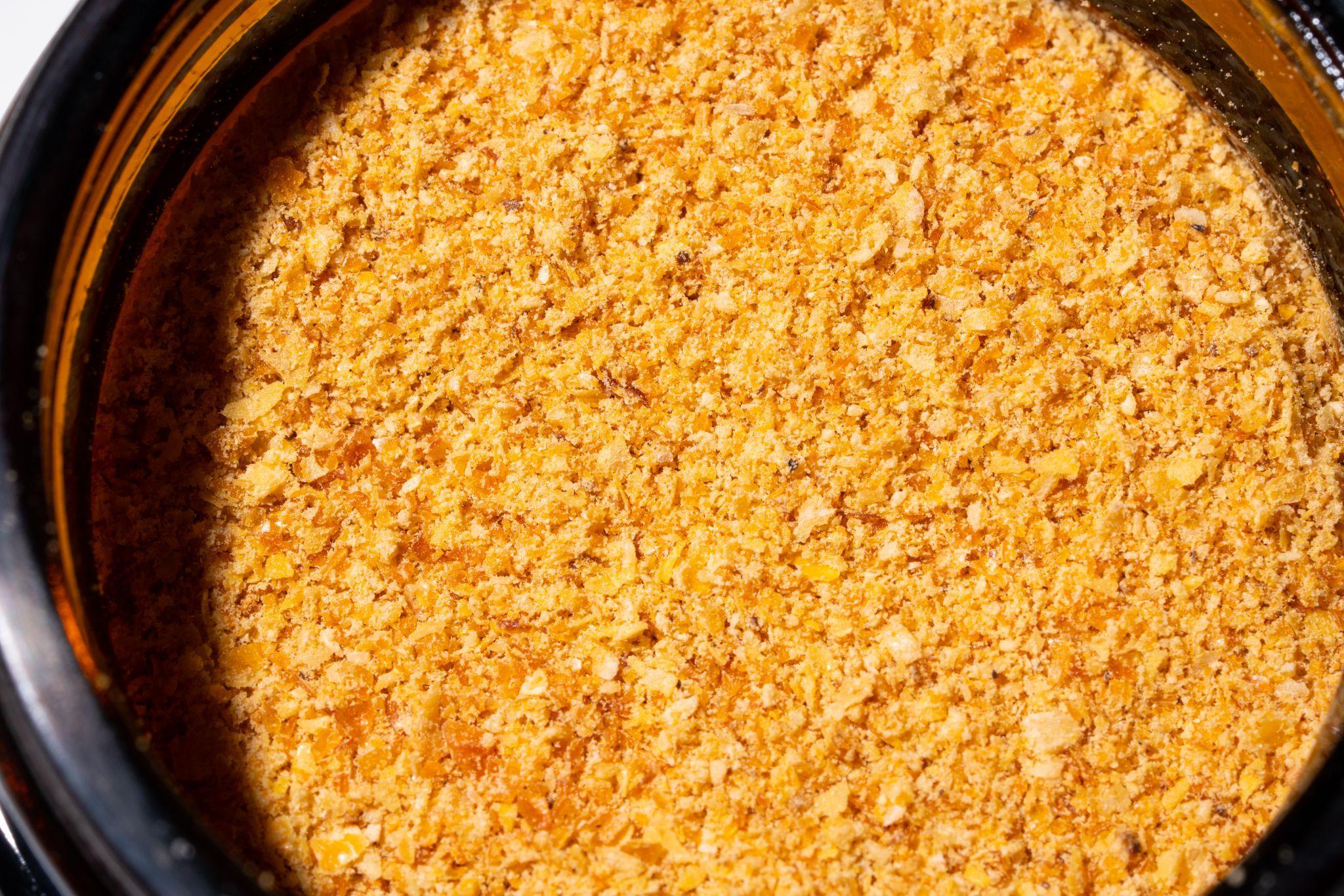
Calabrian Chile Flakes
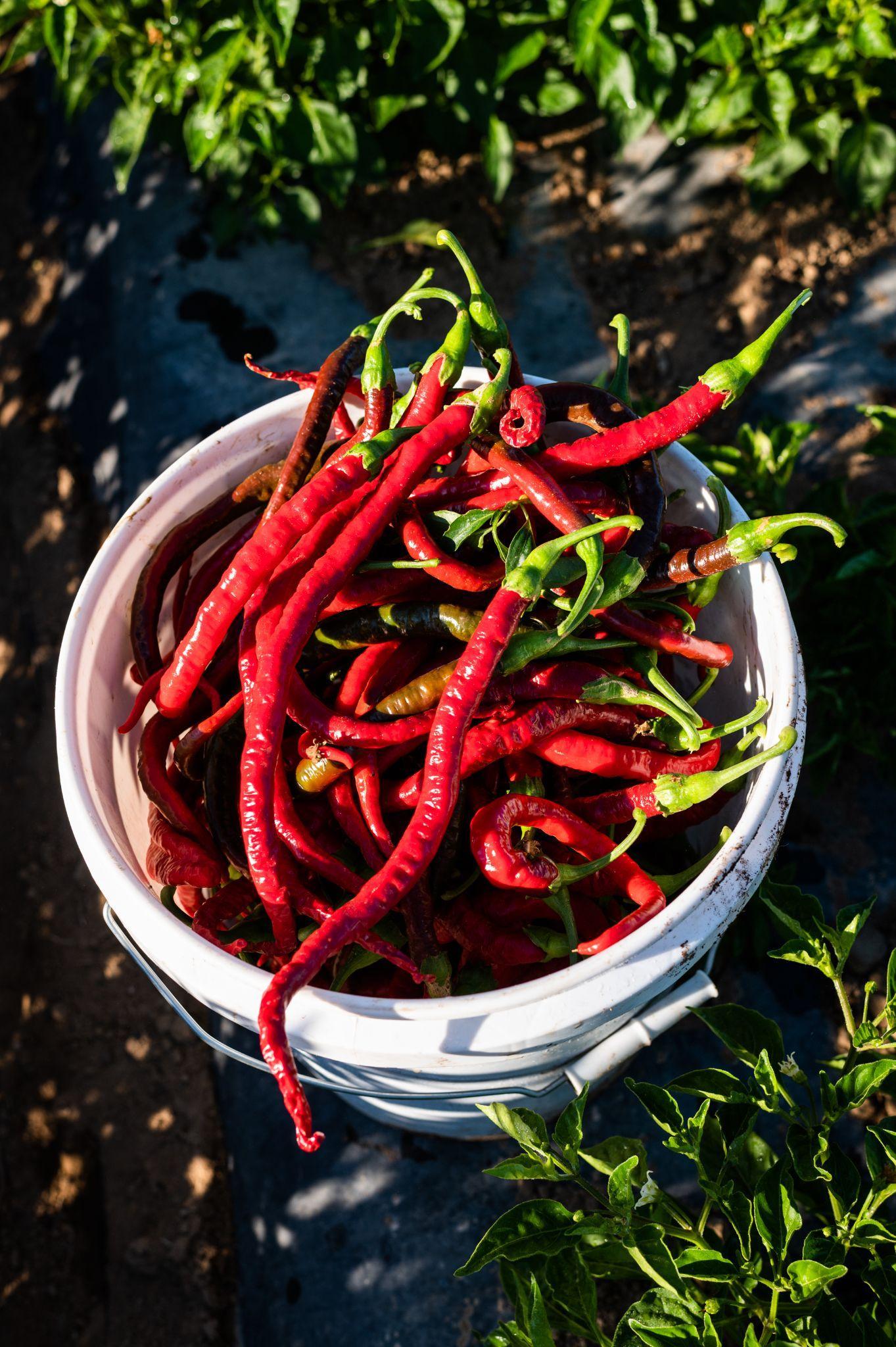
I think we’re in our third year of calabrian chile flakes here at the farm, and they’ve become a favorite of many, including the New York Times and The Kitchn. For years I searched for the chile that would be great to dry and would make the perfect chile flake for shaking on a pizza. As a farmer that prides myself in knowing the origin of the chiles I eat, using generic “crushed red chile flakes” really made me sad. After trying out a few different chiles for my perfect pizza flake, we found it in a type of cayenne chile that has roots in Calabria, Italy.
These chiles are long and spindly, grow in wild shapes, and can be over a foot in length (our local county fair board wasn’t impressed by the fun shapes, giving them a measly 2nd place ribbon at the Mendocino County Apple Fair last year). Their final heat is more of a medium heat instead of blaringly hot. We pass these peppers through our flaking machine twice to get a quasi-uniform size flake and are also left with incredibly spicy super fine powder mixed with the flake.
We use sifters to remove this powder because our original trials resulted in chile flakes that overpowered everything we put them on. Gideon took an early sample back to friends in Boston while visiting and, well, when shaken over pizza, nobody could taste the pizza. In wanting to make it a multi-purpose chile flake that could be used for flavor and heat, we try to remove as much of the fine powder as possible to hit the right balance!


These flakes are shiny and filled with their natural chile oils and are fruity with the right amount of heat. Use them as you would crushed red chile flakes and find your food having more flavor than just a punch of heat. While they can really be used in any cuisine, my cooking with these skews Italian. It’s an easy way to add heat and their flavor goes with everything. They are truly perfect on pizza.
One of Gideon’s favorite movies is Chef, and for those that may not have the movie memorized as much as Gideon, there’s a great scene where Jon Favreau makes the most perfect plate of Pasta Aglio e Olio for Scarlett Johansson. Chef Roy Choi helped create this recipe for the movie and it really is perfect. Use all the garlic. Add all the cheese. And don’t skimp on the chile flake. It’s delicious.
The Calabrian chile flakes would also be the perfect addition to a batch of chile crisp, any recipe calling for red chile flakes or crushed red pepper, and are delicious in our Garlic Knots (made with store bought pizza dough to make things easy!). It’s been rare that folks don’t re-order these chile flakes once they have tried them.
Whole Dried Espelette Chiles

A few years ago we decided to grow a selection of Mexican chiles and dry them whole instead of turning them into powders and flakes. This year, we have 7 different kinds of chiles that we’re growing for whole dried chiles including Ancho, Mulato, Guajillo, Pasilla, Cascabel, Yahualica Chile de Árbol, and Espelette. I’ve had fun learning how to cook with whole chiles and have also enjoyed the different opportunities the chiles have brought our way.
This spring we worked with FEED Sonoma, a Bay-Area food distributor, to bring bags of our whole chiles to the Redwood Empire Food Bank in Sonoma County. The Mendocino-Lake Food Hub in Ukiah was also able to include bags of chiles in their Bounty Box program that were given to farmworkers. Both of these programs were funded by Farms Together, a program administered by Community Alliance with Family Farmers through funding from the USDA, CA Dept of Food and Agriculture, and the CA Dept of Social Security. We were able to sell bags of our whole dried chiles at their regular wholesale price to both of these food distributors who then sent them out within their networks. Our farm was recognized as a great fit for this program since we are woman-owned and grow a crop that is culturally appropriate for the majority of the population in our area. It felt great to know that our bags of chiles were headed to folks that would really appreciate them.
There’s a lot of things you can do with whole chiles, especially the whole Espelette chiles. For those not experienced with whole dried chiles we must surmount the hurdle of slight intimidation! The simple way to start is to add one or two to a pot of beans while you are cooking it. You can mash it up into the beans when they are done cooking or remove it, leaving only the flavor behind. You can also use a bag to make a jar of salsa. This is our master salsa recipe that can be modified as you’d like. You could go a little more advanced and make Arcelia’s Mole de Pollo. It’s fine to use all Espelette for the mole if you don’t have the others on hand.


Chili Peppah Water
I’m really excited for you to try this box’s “made with our chiles” inclusion of Chili Peppah Water. This is a Hawaiian style sauce made by Kiki Aranita’s company, Poi Dog Sauces. Kiki is part of our large circle of Philly/PA based food folks and has been using our whole dried Espelette and Ancho chiles in her Chili Peppah Water since 2021. Kiki and I chatted mid-June about Poi Dog. Any quotes in here are what Kiki had to say.
After a tenure in the field of ancient Greek, epic poetry, and Latin, Kiki left academia and started a food truck called Poi Dog in Philly in 2013. Poi Dog means mutt or mixed breed in Hawaiian pidgin. While not native Hawaiian, Kiki grew up in Hawai’i and deeply missed her family’s food. The food truck later turned into a brick and mortar restaurant serving plate lunch, poke, and musubi, with plenty of bottles of Chili Peppah Water on the counters. While the restaurant was a Philly favorite, the pandemic required Kiki to make a hard pivot and close the restaurant.
Following the closure, Kiki was cooking at an on-farm dinner in New York and made large amounts of Chili Peppah Water with the farm’s own chiles. When some of her food industry friends tasted it, they encouraged her to actually bottle it up and sell it. These friends helped her figure out how to start a food business and along with her colleagues at the Drexel Food Lab, an innovation lab that helps develop food products, Kiki left with some initial test batches and a formula to send to a co-packer to get started. And thus, Poi Dog was now a sauce company.
In Kiki’s words, “These sauces speak to our very complex food culture that arose from many many generations of immigration to the islands as a result of plantation owners sourcing laborers from around the world for their sugar cane and later their pineapple plantations. Poi Dog is an homage to my ancestors that worked and grew up on these plantations.”

Every part of the brand Kiki developed is filled with reverence to her family history.
At a backyard BBQ or luau with Kiki’s family, you are more than likely to find an old Tropicana bottle filled with vinegar, sugar, onion, Hawaiian chiles, and water. This is the homemade Chili Peppah Water. “I didn’t make many changes to my family’s sauce. The only difference is that I put a label on my bottle and we use new bottles.” And if you’re in Hawai’i, any diner or poke stand will definitely have a bottle of soy sauce and next to that a recycled bottle filled with vinegar and chiles, the establishment’s own Chili Peppah Water. every single table, it just doesn't have a label.”
The pink pattern on her labels is Hawaiian Palaka. As Kiki told me, “Palaka is not gingham or plaid. It is the pattern that all sugar cane plantation workers wore out in the field. It’s the denim of Hawai’i. It predates the colorful patterns of Aloha shirts.” this conversation, I had no idea that Aloha shirts were originally made from leftover flowery kimono fabric.
Before folks started wearing these Aloha shirts, people were most likely wearing Palaka. And to bring it full circle, Kiki shared, “My grandmother grew up on Camp 7, which is now the Kauai Coffee Company land. She worked in a plantation store … in the notions department so I imagine she probably sold palaka fabric to plantation workers.”
“All these nostalgic aspects of Hawai’i, Palaka fabric, the food that was served at Poi Dog, they all came from the sugar cane plantation era that my family is rooted in.”
Our Boonville grown chiles are the perfect addition to Kiki’s Chili Peppah Water because Hawaiian food is not actually very spicy and our chiles lean more in the direction of tons of flavor compared to mind-numbingly hot. “Our idea of spicy is really different from a Thai person's idea of spice. I've given [chili peppah water] to my Indian friends who think it's delicious but want it to be spicier,” Kiki told me.
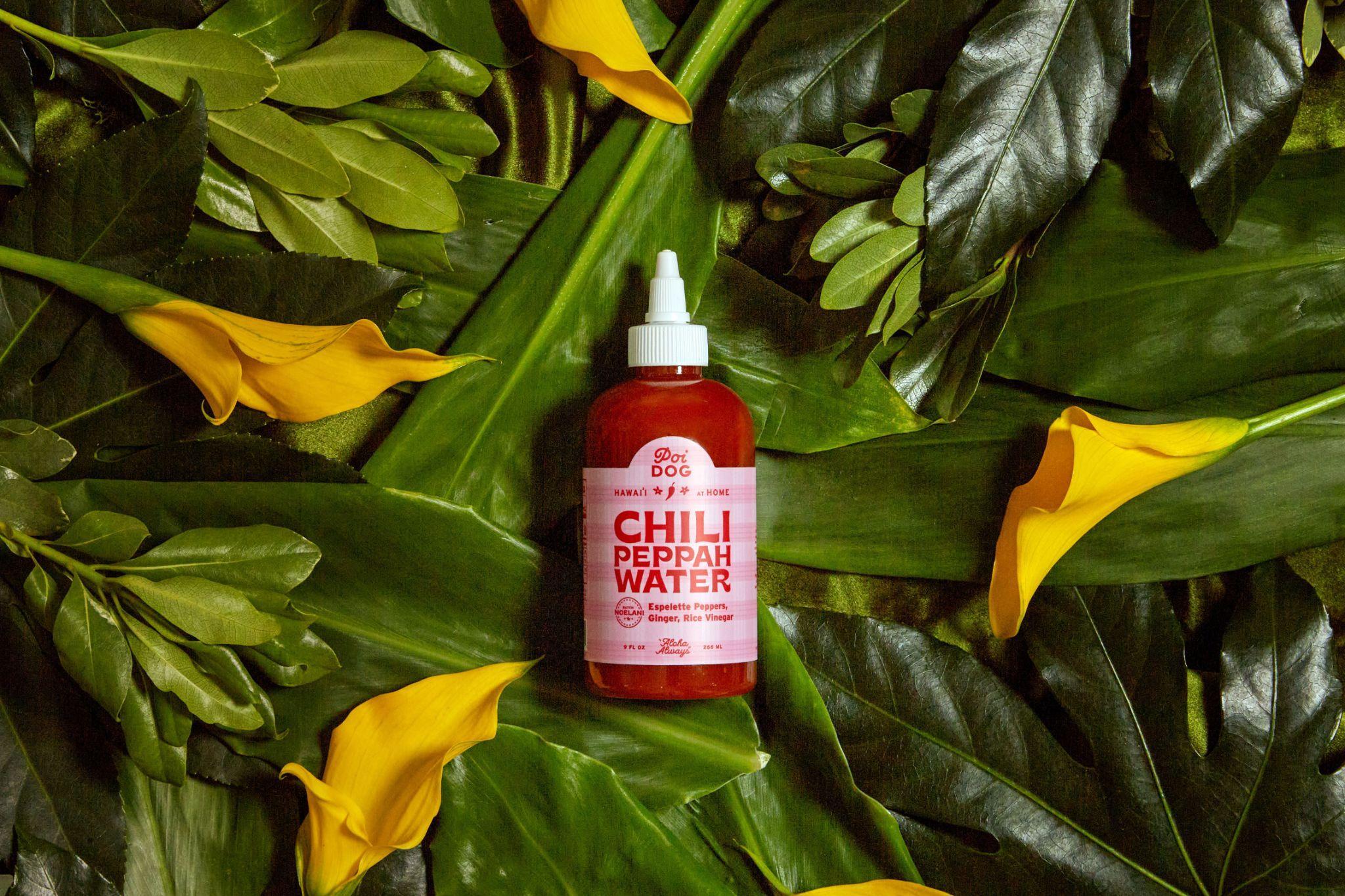
Many iterations of her Chili Peppah Water were made before she found the right peppers. She needed something that had a richness and roundness, wasn’t too smoky and also wasn’t aggressive in heat. Our whole Espelette and Ancho chiles worked perfectly. Kiki told me that she wasn’t able to get the same depth of flavor from chiles she sourced from other producers. And even more special is another ode to her family in her choice of chiles: Kiki’s great grandfather is Basque (just like our Espelette chiles) and she has a Basque last name.
Kiki said, “Using a Basque pepper appealed to me so much because I’ve created something that is super nostalgic and meaningful to my family and other families as well but I wanted it to have a special Aranita flavor. It's not something I talk about very frequently, but it's one of those things that is such a complex and important product to me. And also the Espelette peppers you have are really good!” I would have to agree.
Using this sauce is as simple as Chili Peppah Water on everything. “It’s important that we make this for every BBQ because we splash it on grilled fish, steak, and rice.” It can be splashed over your whole plate lunch, over any rice dish, and over any fish dish. Use it on a Hawaiian macaroni salad. Use it in a poke bowl. Kiki recommends it on scrambled eggs, too. Squeeze it on roasted or steamed vegetables. Use it as a marinade. Since it is vinegar based, use it as part of a salad dressing. Add it to a pot of Hawaiian Saimin (noodle soup), a favorite of ours on Kauai last year. Use it on raw oysters. Make Kiki’s Shoyu Ahi Poke and add some Chili Peppah Water. You can also add it to cocktails. Some of Kiki’s bartender friends have added a splash to a martini instead of using olive brine. There’s really so much you can do with it! Kiki also has a variety of recipes on her website or you can check out Poi Dog on instagram and see what she’s making with it. And while it does say water on it, we wouldn’t recommend drinking it straight like some tourists may have…
If you love the Chili Peppah Water, Poi Dog also makes a Huli Huli sauce and a Guava Katsu Sauce. You can find them here!
And with that, I’m now craving a Hawaiian plate lunch and need to go find some recipes to make Huli Huli chicken, mac salad, and rice!


There was supposed to be mustard in this box.
A somewhat chunky, whole grain mustard, with a base of honey for sweetness and Smoky Piment d’Ville to give it a beautiful color and just a hint of spice. When made right, it is delicious. The color wows, the spices blend nicely and the product, for those who like mustard, I’m told is delicious. And yet. It is not in this box.
Enter the world of co-packing. A co-packer is basically a big ole company that you contract with to make your recipe into a product, usually at some degree of scale. If you’re a long time follower of the farm, you’ll remember our Comapeño Tomato Jam and the Citrus and Chile Marmalade. These were both made for us by a co-packer. Our strawberry and chile jam is made by the Apple Farm down the road from us, who, in essence, is co-packing for us.
The co-packer allows for efficiency of scale. While I could rent a commercial kitchen and make the mustard, I don’t have access to the equipment to do it at scale in a cost effective fashion. In the back of my head I knew when Preserve Farm Kitchen in Petaluma closed (the folks who made the other jams for us) it was a big bummer. But as I went out on my own to try and find a facility to replace her capacity, I’ve struck out SO many times. And absolutely nobody wants to touch seasonal produce. Make a tomato jam with fresh tomatoes that involves a 4 hour cook time to evaporate the water to get to the consistency we want? Absolutely not. One copacker told me ‘we need to be done with each batch in an hour’.
This vacancy of smaller co-packers willing to work not only with smaller clients, but also handle fresh produce creates a significant barrier for place based value-added products to come to realization. Small-scale producers, who often value fresh, locally sourced ingredients, find themselves at a disadvantage when co-packers focus on standardized goods.
This centralization and standardization limits our options, forcing us to either compromise on quality by using less fresh ingredients or face exorbitant costs to maintain our standards independently (cue heading to the commercial kitchen without the right equipment).
As a result, we’re stuck. We simply don’t have the ability to create these products (we’re farmers after all). Other farms who want to diversify also struggle to bring products to market, and delicious, high-quality local products that preserve the season flounder. As a result, it’s hard to bring local products to any sort of local scale, further stifling the growth of local food economies. This not only undermines the potential for regional food innovation but also hinders small farms from flourishing, making the market less dynamic and more homogenized.

Since I’ve started writing this little article I’ve dreamed about collaboration. I’ve done some basic googling to find mustard producers in California (surprisingly hard?), but also had secretive thoughts about convincing our friends who make ‘close’ products to just sprinkle a bit of our chiles in there, and maybe another tweak or two. But these dreams are exactly that. Dreams.
There is not a mustard in this box, and I haven’t yet given up on bringing it to life. I even considered making 100 jars of mustard to go in these boxes at home, but after I thought I broke the vitamix when making a case, I decided maybe not. In the interim, if you’d like to make our mustard yourself, I encourage you to dive in. It’s pretty easy!
Whole
Grain Piment d’Ville Mustard - Yields 3 to 4 8-ounce jars
1 teaspoon onion powder (4 grams)
1 teaspoon garlic powder (4 grams)
2 tablespoons Smoky (or any) Piment d’Ville (20 grams)
1½ cups room temperature water (330 grams)
½ cup yellow mustard seeds (88 grams)
¼ cup brown mustard seeds (44 grams)
¼ cup dry mustard, packed (35 grams)
1 cup apple cider vinegar (at least 5% acidity) (225 grams)
⅓ cup honey (113 grams)
½ tsp salt (2 grams)
1. Add onion powder, garlic powder, and Piment d’Ville to a saucepan and add 1 cup of water. Bring to a boil over high heat then cover and remove from heat. Chill to room temperature (about 70° F).
2. Add yellow and brown mustard seeds to Piment d’Ville mixture. Steep, covered, for 30 minutes.
3. After 15 minutes, combine dry mustard and remaining 1/2 cup water. Meanwhile, if canning, prepare a water bath canner, jars, and lids.
4. Transfer mustard seeds and any remaining liquid to a blender. Pulse several times until some of the mustard seeds are cracked and beginning to break down. Add dry mustard and water mixture. Blend again. Add vinegar, honey, and salt. Blend until mustard is as smooth as you like it.
5. If not canning, divide mixture into jars and store in the refrigerator.
6. If canning, return mustard mixture to the saucepan. Bring to a boil, stirring constantly. Remove from heat. Spoon hot mustard into hot jars, leaving 1⁄2-inch headspace. Remove air bubbles. Wipe jar rim. Center lid on jar. Apply band and adjust to fingertip-tight. Repeat until all jars are filled.
7. Place jars in boiling-water canner. Process jars 10 minutes. Turn off heat; remove lid, and let jars stand 5 minutes. Remove jars and let cool. Once cooled, check that lids are sealed (concave), remove bands and store in a cabinet. Store any jars that haven’t sealed in the refrigerator.
Note: The flavor of this mustard will mellow as it matures. It is edible immediately but will mellow out over the course of the next several weeks.

